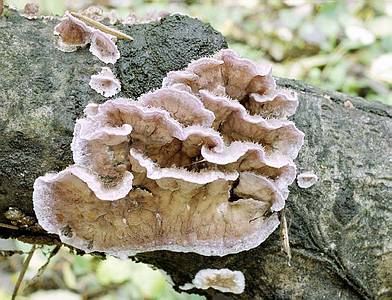Stereom purple (Chondrostereum purpureum)
- Pipin: Basidiomycota (Basidiomycetes)
- Ìpín: Agaricomycotina (Agaricomycetes)
- Kilasi: Agaricomycetes (Agaricomycetes)
- Ipin-ipin: Agaricomycetidae (Agaricomycetes)
- Bere fun: Agaricales (Agaric tabi Lamellar)
- Idile: Cyphellaceae (Cyphellaceae)
- Genus: Chondrostereum (Chondrostereum)
- iru: Chondrostereum purpureum (Stereum purple)
 Apejuwe:
Apejuwe:
The fruit body is small, 2-3 cm long and about 1 cm wide, at first prostrate, resupinate, in the form of small spots, then fan-shaped, adnate sideways, thin, with a wavy slightly lowered edge, felt-hairy above, light, grayish-beige, brownish or pale gray-brownish, with faint concentric darker zones, with a lilac-white growing edge. After frost, in winter and spring it fades to a grayish-brown color with a light edge and almost does not differ from other stereums.
The hymenophore is smooth, sometimes irregularly wrinkled, lilac-brown, chestnut-purple, or brown-purple with a light whitish-purple edge.
The pulp is thin, soft-skinned, with a spicy smell, two-layer colored: grayish-brown above, dark gray, below – light, creamy.
Tànkálẹ:
Stereoum purple grows from mid-summer (usually from September) until December on dead wood, stumps, construction wood or parasitizes at the base of the trunks of living deciduous trees (birch, aspen, elm, ash, ash-shaped maple, cherry), numerous tiled groups, often. Causes white rot and milky sheen disease in stone fruit trees (in the middle of summer a silvery coating appears on the leaves, the branches dry out after 2 years).
Igbelewọn:
Olu ti ko le jẹ.









